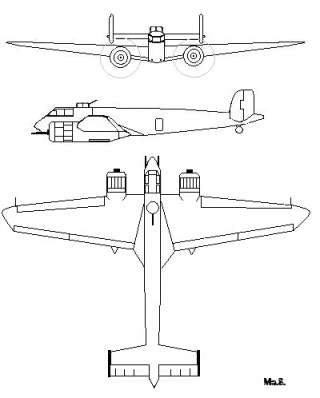Savoia-Marchetti SM.89
| SM.89 | |
|---|---|
 | |
| SM.89 with Regia Aeronautica insignia | |
| Role | Bomber aircraft |
| Manufacturer | Savoia-Marchetti |
| First flight | 1941 |
| Introduction | 1942 |
| Number built | 1[1] |
|
| |
The Savoia-Marchetti SM.89 was a bomber aircraft made by Savoia-Marchetti. The SM.89 was developed by Alessandro Marchetti and the prototype (MM.543) made its first flight in September 1941 in Vergiate, with the test pilot Lieutenant G. Algarotti behind the sticks. Only one was made.
Development
The SM.89 was intended to be a bomber/attack aircraft, something similar to Junkers Ju 88. The aircraft displayed some impressive features, but it was not a new project, rather an extrapolation from the earlier SM.84. The project utilized the wings, the aft fuselage and the mixed construction of the latter almost untouched, with a totally redesigned nose. The fuselage was made from a skeleton of steel tubes, covered with duralumin and wood back as far as the dorsal turret, the remainder of the fuselage being of wood and fabric construction. The wing was made of wood using three spars and a covering of compensate wood. The control surfaces comprised slats and flaps, and the ailerons, that were lowered partially with the flaps to increase lift.
The forward fuselage was the real difference between the SM.84 and SM.89. The forward fuselage housed only one pilot, after him there was a radio operator/gunner, and finally a gunner. Therefore the aircraft had only half a crew, compared to the S.84. The fuselage was much more cramped than the S.84's, this was also due to the tandem position for all the crew, because a smaller crew area meant that less protection was needed.
The aircraft did not have a nose engine, unlike many contemporary Italian designs. The SM.89 was a two-engine aircraft so that the nose could be used to house weapons. The nose section was rounded, short, and inclined sharply to provide good visibility for attacks on surface targets. The weaponry was mainly based on the 37 mm (1.46 in) Breda anti-aircraft guns, used in the anti-tank and anti-ship roles. Three 12.7 mm (.50 in) Breda machine guns were also fitted in the nose. A further Breda machine gun was also fitted in the dorsal turret, and another was in a new model turret, a remote-controlled one, in the ventral position.
The aircraft could carry 700 bomblets or 1,400 kg (3,090 lb) of bombs or torpedoes under the belly. The aircraft could also be fitted with air brakes for dive bombing. The aircraft's speed also made it possible to use the aircraft as a bomber interceptor, however it was never fitted with a radar.
The Piaggio P.XI engines were too weak for the aircraft, so instead, two Piaggio P.XII RC.35 were used. These could develop 1,119 kW (1,500 hp) at take-off. These engines were in a more compact installation than those of the Piaggio P.108s and CANT Z.1018s. The aircraft could also carry 2,700 L (710 US gal) of fuel in self-sealing fuel tanks, which gave the aircraft an effective range of 720 km (450 mi).
The SM.89 had very heavy armour protection. The armour for the front and windscreen totalled 300 kg (660 lb), another 300 kg (660 lb) of armour protected the engines, and a further 80 kg (180 lb) was used in the aft armour. The aircraft was also possibly equipped with a CO² fire extinguisher system.
Operational service
The aircraft flew in 1941, but it was not until September 1942 that it was sent to Guidonia for evaluation tests. The aircraft was taken into use in March 1943, seeing service in the anti-tank and other roles. The results were quite good, with its firepower second only to the P.108A.
The real problem with the S.89 was the power and the reliability of the engines. 2,237 kW (3,000 hp) was not enough for the 12,600 kg (27,780 lb) aircraft. It was planned to install Piaggio P.XV or Alfa Romeo 135 engines on the aircraft, but this never took place.
The pilots found the aircraft to be difficult to fly, being too slow, and difficult to land. During flight, the aircraft needed to have an elevated angle of attack so as not to lose altitude. The aircraft was later forgotten and sent to Foligno in July 1943. It was captured by the Germans after 8 September 1943 and vanished.
The aircraft could possibly have been more successful had it carried less weapons or armour. Both combined caused the weight to surpass 12,000 kg (26,460 lb). The attempt to cover both the attack and even interception requirements made this aircraft even less reliable and flyable than the already mediocre S.84.
Specifications (S.89)

Data from ITALlAN CIVIL AND MILITARY AIRCRAFT 1930 - 1945[2]
General characteristics
- Crew: 3
- Length: 16.85 m (55 ft 3 in)
- Wingspan: 21.04 m (69 ft 0 in)
- Height: 4.5 m (14 ft 9 in)
- Wing area: 61 m2 (660 sq ft)
- Empty weight: 8,800 kg (19,401 lb)
- Max takeoff weight: 12,634 kg (27,853 lb)
- Powerplant: 2 × Piaggio P.XII RC.35 18-cyl. air-cooled two-row radial piston engines, 1,119 kW (1,501 hp) each
Performance
- Maximum speed: 440 km/h (273 mph; 238 kn)
- Range: 720 km (447 mi; 389 nmi)
- Service ceiling: 6,700 m (21,982 ft)
- Rate of climb: 5.4 m/s (1,060 ft/min)
Armament
- Guns:
- two 37 mm (1.457 in) cannon
or
- two 54 mm (2.126 in) cannon
and
- two fixed forward firing 12.7 mm (0.500 in) machine guns
and
- two 12.7 mm (0.500 in) machine-guns in dorsal and ventral positions.
Notes
- ↑ Savoia-Marchetti SM.89
- ↑ Thompson, Jonathan (1963). ITALlAN CIVIL AND MILITARY AIRCRAFT 1930 - 1945. New York: Aero Publishers. p. 284. ISBN 0-8168-6500-0.
Sources
| Wikimedia Commons has media related to Savoia-Marchetti. |
- Lembo, Daniele, i distruttori della Regia, Aerei nella Storia n.46, pag. 9-11.